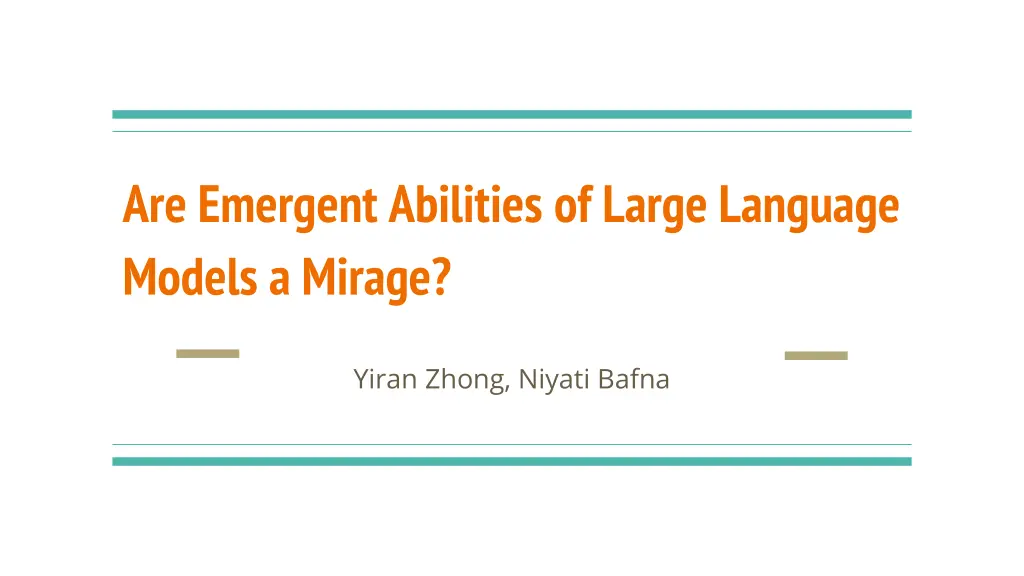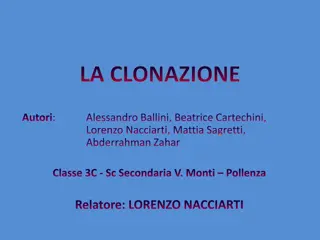
Exploring Emergent Abilities of Large Language Models
Dive into the concept of emergent abilities in large language models, uncovering the mirage they present. Understand how evaluation metrics, discontinuity in measurements, and non-linearity impact the true nature of these capabilities.
Download Presentation

Please find below an Image/Link to download the presentation.
The content on the website is provided AS IS for your information and personal use only. It may not be sold, licensed, or shared on other websites without obtaining consent from the author. If you encounter any issues during the download, it is possible that the publisher has removed the file from their server.
You are allowed to download the files provided on this website for personal or commercial use, subject to the condition that they are used lawfully. All files are the property of their respective owners.
The content on the website is provided AS IS for your information and personal use only. It may not be sold, licensed, or shared on other websites without obtaining consent from the author.
E N D
Presentation Transcript
Are Emergent Abilities of Large Language Models a Mirage? Yiran Zhong, Niyati Bafna
What are emergent capabilities? Defined by the following things: - Sharpness: these abilities simply appear - Unpredictability: we don t know when they will appear - Mysticism: they are part of the LLM dark arts, a miracle of scale - Hype: they indicate that the LLM is *fundamentally* different from the LM. Emergent Abilities of Large Language Models (Wei et al, 2022)
But These abilities only show up on tasks measured by metrics with certain properties Claim of paper: emergent properties are a mirage Implying The LLM is still a familiar creature which we can understand by extrapolating from little LMs. (*phew*)
Issues with Evaluation Non-linear or discontinous metric Bad statistics - Test dataset resolution - Insufficient sampling
Discontinuity of Metrics Intuition #1: All-or-nothing evaluation doesn t let you see in-between progress Example: Multiple-choice - Instead, using Brier Score (MSE b/w probs) Our note: you still might argue that a dataset-level metric like a sum of accuracies is continuous
Statistics: Resolution and Sampling Intuition #2: a dataset has an inherent granularity that it lets you evaluate any model at. If the resolution is too high, you will miss things. Resolution: 1/size - Resolution of n coin flips: ( )^n If resolution is too high, existing model performance will be missed Intuition #3: If the dataset covers a small range of difficulty, you will see all- or-nothing performance given a model Sample over a good enough range! - And LLMs will show expected behaviour in performance degradation
Non-linearity Intuition #4: We know that per-token cross-entropy behaves smoothly. If measured metric is non-linear function of length, then long sequences become very hard (1) Non-linear: each token needs to be right (p^L) (2) Linear: number of tokens we got right (L.f(p)) where f is a linear function Why is (2) better than (1)? - This can be understood as a resolution/discontinuity problem per sample - (2) lets us measure in-between progress of getting some tokens right
Linearity in target length Note: We are not measuring performance along target length - But: when L is high, and you don t have good sampling along the curve, the (actually smooth) curve will appear unsmooth - The authors say that decreasing resolution was a way of fixing this problem, indicating that this is only a problem with bad resolution
A little deeper into the linearity argument (1) Let s think about - A = p^L , B = f(p).L where p is the model probability of the right token - A, B: probability of scoring 1 given metric (Accuracy, Token edit distance) Now, imagine that for small N, p is small, and grows smoothly with N - There will come a sudden time when p is sufficient, - For B: We see a little jump every time some token p becomes sufficient - For A: We ll see a single, dramatic, jump when all L p s become sufficient
A little deeper into the linearity argument (2) Note that - - - - - - Dependence on p (rather than L) seems more relevant, since p varies with N Both A and B are smooth in p and therefore in N But A and B are just prob(metric = 1) , not metric = 1 Both Accuracy and TED are unsmooth in p and therefore in N This is because we do thresholding/maxing per token Something like C = L.p^10 is as bad as B Non-smoothness is coming from discontinuity (which can be thought of as per-sample high resolution), not from non-linearity (either in p or L) - But when metric is non-linear, non-smoothness is more dramatic Seems like: if we switched to Brier Score for (non-linear) Accuracy, we would end up with a final smooth metric wrt N despite it being non-linear
InstructGPT/GPT3s emergent abilities Testing whether the "emergent abilities" of GPT-3 models in arithmetic tasks are real or just an illusion caused by the metrics used. GPT3: publicly queryable model Task: multiplication between two 2-digit integers (e.g., 45 * 67) addition between two 4-digit integers (e.g., 1234 + 5678)
Prediction 1 Changing from a nonlinear/discontinuous metric to a linear/continuous metric reveal smooth improvements in model performance Nonlinear metrics, like Accuracy making improvements look sharp and unpredictable linear metrics like Token Edit Distance make improvements look more gradual and continuous
InstructGPT/GPT3s emergent abilities (2) Increasing the resolution of measured model performance by using a larger test dataset should also reveal smooth, continuous improvements For nonlinear metrics, a smaller dataset can make the model look like it's suddenly getting better Longer sequences of input data should lead to predictable changes in model performance For accuracy, performance should degrade sharply for longer sequences (geometrically). For token edit distance, performance should degrade more smoothly (quasilinearly).
Meta-Analysis Use BIG-Bench, a collection of benchmark tasks used to evaluate language models. predictions are extended to a broader range of models and tasks. Further studying on whether emergent abilities are dependent on specific metrics, not on task-model family pairs
Emerging score Y is model performance at scale x Numerator: the difference between the best and worst performance scores. Denominator: how gradual the performance improvements are over model scale. higher score indicates sharper, less gradual changes in performance, suggesting the presence of an emergent ability
Emergent abilities appear only under specific metrics Of the 39 preferred metrics in BIG-Bench, only 5 showed any evidence of emergent abilities 5 metrics that did show emergent abilities were primarily nonlinear and/or discontinuous metrics Multiple Choice Grade and Exact String Match. Multiple Choice Grade is discontinuous, and Exact String Match is nonlinear
Two metrics account for over 92% of emergent abilities Multiple Choice Grade (a discontinuous metric) Exact String Match (a nonlinear metric)
Try different model and metrics focusing on the LaMDA model family exhibited emergent abilities under the Multiple Choice Grade evaluation metric was switched to a continuous one Brier Score Finding: emergent abilities are more smooth when switching to a continuous metric
Emergent ability on vision task emergent abilities can be artificially induced in neural networks for vision tasks by manipulating the metric 1: define a discontinuous metric that measures a network s ability to reconstruct CIFAR10 images 2: induce emergent abilities in autoregressive transformers trained to classify handwritten characters from the Omniglot dataset.
Deep network reconstruct image Reconstruction metric: X_n is origin image, x^hat is reconstructed image, c is threshold value introduce the emergent ability by setting boundary between acceptable reconstruction and unacceptable one.
Classify Omniglot handwriting characters Metrics: Accuracy (gives the model a score of 1 only if it correctly classifies all characters in a sequence, If the model makes even one mistake, it gets 0.)
Artifacts or Abduction: How Do LLMs Answer MCQs without the Question? Yes this is a thing LLMs are able to do well on MCQ benchmarks without the question - Paper looks at Memorization: show that the models haven t simply memorized the benchmark Priors: Correct answer text is not inherently more probable than others Choice dynamics and question inference: This is largely what s happening - - - Takeaway: LLM evaluation on MCQA benchmarks needs to be further investigated - what is it actually learning?


